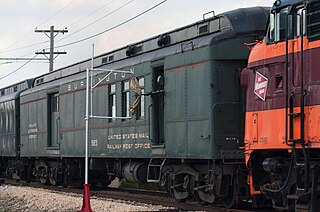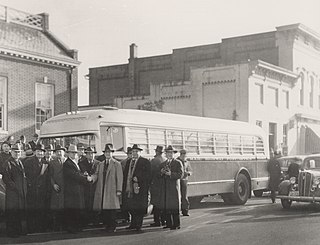The Railway Mail Service of the United States Post Office Department was a significant mail transportation service in the US from the mid-19th century until the mid-20th century. The RMS, or its successor the Postal Transportation Service (PTS), carried the vast majority of letters and packages mailed in the United States from the 1890s until the 1960s.

The United States Post Office Department was the predecessor of the United States Postal Service, established in 1792. From 1872 to 1971, it was officially in the form of a Cabinet department. It was headed by the postmaster general.

A ZIP Code is a system of postal codes used by the United States Postal Service (USPS). The term ZIP was chosen to suggest that the mail travels more efficiently and quickly when senders use the code in the postal address.

In Canada and the United States, a railway post office, commonly abbreviated as RPO, was a railroad car that was normally operated in passenger service and used specifically for staff to sort mail en route, in order to speed delivery. The RPO was staffed by highly trained Railway Mail Service postal clerks, and was off-limits to the passengers on the train.
The Railway Mail Service (RMS) Library is a major collection of materials pertaining to en route distribution history. Incorporated in May 2003, it can assist researchers interested in Railway Mail Service, route agent, Seapost, Railway Post Office (RPO), and Highway Post Office (HPO) history. The collection has many unique, original-source documents that provide answers to questions dealing with the transportation and distribution of USA Mail between 1862 and 1977, as well as other countries during the 19th century and 20th century.

The term highway post office refers to brightly colored red, white and blue buses used to carry mail to multiple areas over wide distances.
An air mail facility is an installation for airmails of the United States.
Terminal railway post offices were sorting facilities which were established by the Railway Mail Service to speed the distribution of parcel post. These offices were usually located in or near railroad stations in major cities or junction points. Terminal railway post offices operated generally from 1913-1914 into the mid-1960s, before their function was absorbed by post office sectional centers.

From the 1880s until well into the 1950s, virtually all long-distance transportation of United States Mail was performed by the railroads. Specially equipped railway post office (RPO) cars were a part of most passenger trains, the cars staffed by highly trained railway postal clerks who sorted mail as the train sped along its route. The growth of this mail distribution network paralleled the expansion of the railroads, allowing mail to be exchanged between routes at junction points where two railroads crossed or shared passenger terminals.
A Seapost was a mail compartment aboard an ocean-going vessel wherein international exchange mail was distributed. The first American service of this type was the U.S.-German Seapost, which began operating in 1891 on the S.S. Havel North German Lloyd Line. The service rapidly expanded with routes to Great Britain, Central America, South America, and Asia. The Seapost service still employed fifty-five clerks in early 1941. The last route of this type was terminated October 19, 1941, due to unsafe wartime conditions on the Atlantic Ocean. The few remaining Seapost clerks transferred to branches of the Railway Mail Service (RMS). Seapost operations for the US Post Office Department were supervised from a New York City, New York, office.
The Postal Transportation Service (PTS) was the renamed successor to the Railway Mail Service of the United States Post Office Department from October 1, 1949. Although this branch of the service had been in charge of all transit mail, some parts had little to do with railroads, even though they were still the most important part of the service. In 1950, of the 32,000 clerks assigned to the PTS, only about 16,000 actually worked on trains. The remainder were in terminals, transfer offices, Air Mail Facility, Highway Post Offices (HPO), administrative offices, etc. Boat Railway Post Office, Streetcar Railway Post Offices, and the Seapost Service had already been discontinued. The name of the Chief Clerk's office was changed to District Superintendent's office.
Streetcar railway post office (RPO) routes operated in several major US cities between the 1890s and 1920s. The final route was in Baltimore, Maryland. The Mobile Post Office Society, Affiliate 64 of the American Philatelic Society, has published monographs detailing the operational history of each route.
The National Postal Transport Association (NPTA) was a labor union representing workers in the Postal Transportation Service in the United States.

Parcel post is a postal service for mail that is too heavy for normal letter post. It is usually slower than letter post. The development of the parcel post is closely connected with the development of the railway network which enabled parcels to be carried in bulk, to a regular schedule and at economic prices. Today, many parcels also travel by road and international shipments may travel by sea or airmail.

Owney, was a terrier mix adopted in the United States as a postal mascot by the Albany, New York, post office about 1888. The Albany mail professionals recommended the dog to their Railway Mail Service colleagues, and he became a nationwide mascot for nine years (1888–1897). He traveled over 140,000 miles throughout the 48 contiguous United States and around the world as a mascot of the Railway Post Office and the United States Postal Service. He was the subject of commemorative activities, including a 2011 U.S. postage stamp.

Mobile post offices deliver mail and other postal services through specially equipped vehicles, such as trucks and trains.

Charlotte May Pierstorff, American girl who was shipped alive through the United States postal system by parcel post on February 19, 1914. After the incident, parcel post regulations were changed to prohibit the shipment of humans.

Mail Delivery is a set of four relief sculptures by Edmond Amateis completed in 1941 for the Section of Painting and Sculpture and displayed at the U.S. Court House and Post Office Building in Philadelphia, now called the Robert N. C. Nix, Sr., Federal Building, at 9th and Market Streets. The reliefs are carved in granite and each measures about 108 inches (2.7 m) in height by 120 inches (3.0 m) in width.

A mail bag or mailbag can be one of several types of bags used for collecting or carrying different types of postal material.

A Pony Express mochila was a removable lightweight leather cover put over a horse saddle for carrying mail and was used by the Pony Express.















